How to Automate HR Processes With AI for Faster Onboarding

Sorry, there were no results found for “”
Sorry, there were no results found for “”
Sorry, there were no results found for “”

It’s Monday morning, and your inbox is already flooded. Three new hires start today, IT hasn’t set up their accounts, the welcome emails didn’t go out, and someone just asked where their onboarding checklist is… again.
If you’re in HR, you know this chaos all too well.
Onboarding should feel exciting—for both the company and the new employee. But when your team is buried in repetitive tasks, the experience suffers. The good news? You don’t have to do it all manually anymore. That’s where artificial intelligence for HR steps in.
In this post, we’ll show you how to automate HR processes with AI to create faster, smarter onboarding experiences—without losing the human touch.
According to the IBM Institute for Business Value, 87% of surveyed leaders believe that AI is more likely to augment their roles than replace them. Human Resources is right on the cusp of this shift, stepping into bigger, more impactful possibilities.
Here’s why you need to use AI in HR:
📚 Read More: Best HR Software for People Teams, Tried and Tested
👀 Did You Know? According to McKinsey & Company, companies that excel at talent management deliver 300% more revenue per employee than the average firm. And yet, many HR teams continue to spend hours chasing forms and managing payroll data.
When deciding which HR process is a worthy candidate for automation, look for bottlenecks that consistently delay outcomes.
Whether it’s interview scheduling or compliance checks, the biggest blockers in your HR workflow are often the easiest wins for AI. They include:
Manually parsing hundreds of resumes is one of the biggest bottlenecks for HR functions. Using artificial intelligence, you can scan applications, extract skills, and rank candidates against job descriptions.
With ClickUp Brain, you can quickly surface candidate information, feedback, and even interview notes from your workspace and other connected HR apps.
Here’s how you can use Brain for interview preparation.
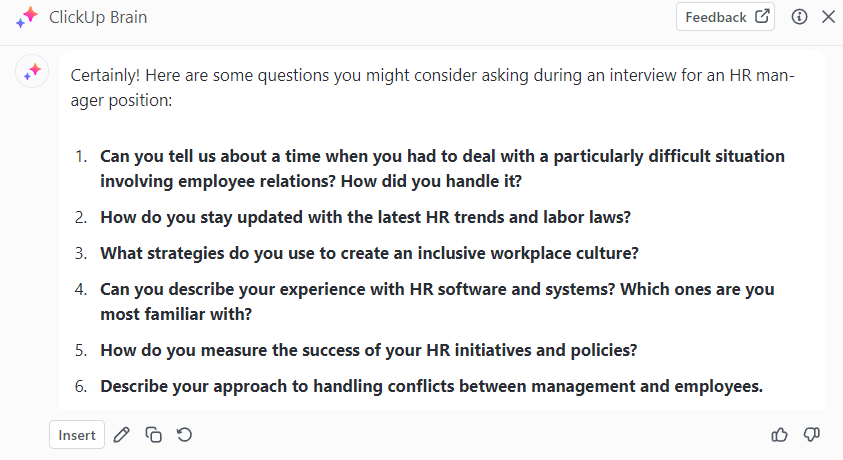
How many emails does it take to book a single interview? Too many. AI scheduling assistants check calendars, suggest slots, send reminders, and even handle last-minute reschedules, giving hiring managers more time to focus on the employee experience.
💡 Pro Tip: Instead of juggling multiple tools, use ClickUp’s AI-powered Calendar to bring it all into one place. It organizes interviews, onboarding milestones, team events, and leave requests in a unified timeline. You can color-code event types, drag-and-drop to reschedule, and even let AI auto-time block key priorities based on your task and goal data.

Chasing IDs, tax forms, and contracts is repetitive and compliance-heavy.
Using employee self-service portals, your new hires can upload documents that are then auto-verified, securely stored, and flagged for errors. The smoother the process, the better the first impression—and the stronger the foundation for employee engagement.
⚡ Pro Tip: If you’re stuck at the onboarding process, the ClickUp Onboarding Checklist Template can lend you a helping hand. Everything from recording employee details to sending the post-onboarding survey is captured, assigned, and tracked in one place.
HR databases often lag when employees update addresses, bank details, or contacts.
AI systems sync updates from AI-powered forms directly into core HR platforms, reducing errors and ensuring records stay accurate. That means HR leaders can rely on clean data for predictive analytics that support long-term planning.
🎥 Watch this video on how to use AI smartly in recruitment:
👀 Friendly Tip: Outdated employee details create silent errors that ripple across payroll, compliance, and reporting. Use free HR templates to centralize employee information and keep records consistent.
Using AI tools, you can analyze an employee’s role, experience, and performance to recommend tailored learning paths. By personalizing development, your HR teams can improve employee engagement as well as performance management.
👀 Did You Know? Unilever, through its Compass program, has pledged to equip every employee with future-fit skills. Their research shows that employees who took part in these workshops boosted their overall productivity by 41%.
AI platforms automate salary calculations, reimbursements, and payslip generation, while also simplifying benefits enrollment with guided eligibility checks.
📮 ClickUp Insight: 32% of workers believe automation would save only a few minutes at a time, but 19% say it could unlock 3–5 hours per week. The reality is that even the smallest time savings add up in the long run.
For example, saving just 5 minutes a day on repetitive tasks could result in over 20 hours regained each quarter, time that can be redirected toward more valuable, strategic work.
With ClickUp, automating small tasks—like assigning due dates or tagging teammates—takes less than a minute. You have built-in AI Agents for automatic summaries and reports, while custom Agents handle specific workflows. Take your time back!
💫 Real Results: STANLEY Security reduced time spent building reports by 50% or more with ClickUp’s customizable reporting tools—freeing their teams to focus less on formatting and more on forecasting.
Reviews often stall because managers juggle too much data. AI can step in and compile metrics, aggregate 360° feedback, and generate summaries—making performance management more consistent, transparent, and data-driven.
This way, employees get fairer evaluations, while HR gains insights for future predictive analytics.
⚡ Pro Tip: ClickUp Dashboards centralize key HR analytics—from employee performance and engagement to turnover trends—all in one customizable view. With AI-powered insights, HR teams can track patterns, spot red flags, and make data-driven decisions faster than ever.
AI chatbots powered by natural language processing handle FAQs instantly, escalate complex issues, and log recurring themes.
With ClickUp Knowledge Management, you can build a centralized HR knowledge base where employees can easily access policies, benefit details, and onboarding guides independently.
You can also set up ClickUp pre-built Auto-pilot agents or build your own custom agents that resolve HR-related queries.
For instance, the HR team’s Channel gets a lot of questions. The People Partner Lead wants to use AI to answer some of these questions and free up their team’s time. They create a Custom Autopilot Agent in the Channel, instructed to answer questions only if the answer is in the knowledge it can access. They specify that the Autopilot Agent should only respond when the user’s message contains a clear and direct example. They even give the Autopilot Agent examples of questions.
Offboarding is just as critical as onboarding, but often lacks a process in place.
AI automates clearance checklists, system deactivation, and exit surveys. By analyzing survey data with predictive analytics, you can uncover attrition patterns and strengthen retention strategies, while ensuring compliance at every step.
📚 Read More: Best Exit Interview Questions to Ask
👀 Did You Know? With the rise of Gen AI, the automation potential of tasks like applying expertise and managing people has jumped to nearly 60%. These are areas once thought too human to automate.
Tired of jumping between tools just to manage one HR process?
ClickUp brings together all your work apps, data, chats, automations, and workflows into the world’s first Converged AI Workspace. You no longer need to hop between apps, SOP docs, chat, and email for approvals. That type of Work Sprawl ends now because with ClickUp, one workspace is all you need for hiring, managing, and supporting a thriving workforce.
Your HR team can focus on people, not paperwork, because they have 100% context and a single place for humans and agents to work, together.
Imagine this: you build a performance management agent using ClickUp Agents. It pings managers when performance review season rolls around, guides them through the process of filling out the data, answers questions naturally from existing SOPs, schedules reminders, summaries, and more, and then communicates the results to the head of HR.
And that’s just scratching the surface
To help you, we’ve got a step-by-step guide for automating HR processes with actionable insights.
Focus on repetitive, rule-based, and high-volume HR tasks. Think: payroll, leave management, candidate screening, onboarding checklists, and compliance reporting.
Before plugging in AI, visualize your current processes with flowcharts or whiteboards. This highlights bottlenecks and inefficiencies that automation can eliminate.
Instead of filling your conference room walls with sticky notes, use ClickUp Whiteboards to map your HR processes digitally.

Using Whiteboards as a virtual canvas, your entire team collaborates in real time. Whether you’re working remotely or on-site for human resource planning, sketch out your current onboarding flow. This means you can draw a map from ‘candidate accepts offer’ all the way to ‘receives laptop and first paycheck.’
And when you spot a bottleneck in your background check, convert it into a ClickUp Task right from the whiteboard. If you don’t know where to start, you can use the ClickUp HR SOP Template that’s built right into Whiteboards.
This framework covers the entire employee lifecycle through its visual format. You can organize HR processes into distinct phases, including Job Profiling, Job Posting, and Hiring. Each of them is defined with steps, participants, inputs, and outputs.
👀 Did You Know: Over a three-year period, organizations using ClickUp achieved an estimated 384% return on investment (ROI), according to Forrester Research. These organizations generated about US $3.9 million in incremental revenue through projects enabled or improved by ClickUp.
Set SMART goals (Specific, Measurable, Achievable, Relevant, and Time-bound). Here are some outcome examples you can aim for:
Here’s where most HR automation projects go sideways: teams get excited about the tech but forget to measure what matters. Don’t be that team!
📮 ClickUp Insight: Nearly 88% of our survey respondents now rely on AI tools to simplify and accelerate personal tasks. Looking to generate those same benefits at work?
ClickUp is here to help! ClickUp Brain can help you improve productivity by 30% with fewer meetings, quick AI-generated summaries, and automated tasks.
📚 Read More: HR Process Improvement with Strategies and Examples
Among all the tools available in the market, how do you determine the right one to get the job done?
Here are some important considerations to look at:
Example in practice: Say your goal is “Shorten average time-to-hire by 25% over the next 90 days with automated screening, scheduling, and feedback workflows’, then you should look for:
Instead of adding yet another standalone tool to your HR stack, ClickUp Brain brings AI directly into the workflows you already manage inside ClickUp. Think of it as a connected AI assistant that works across tasks, docs, goals, and whiteboards.
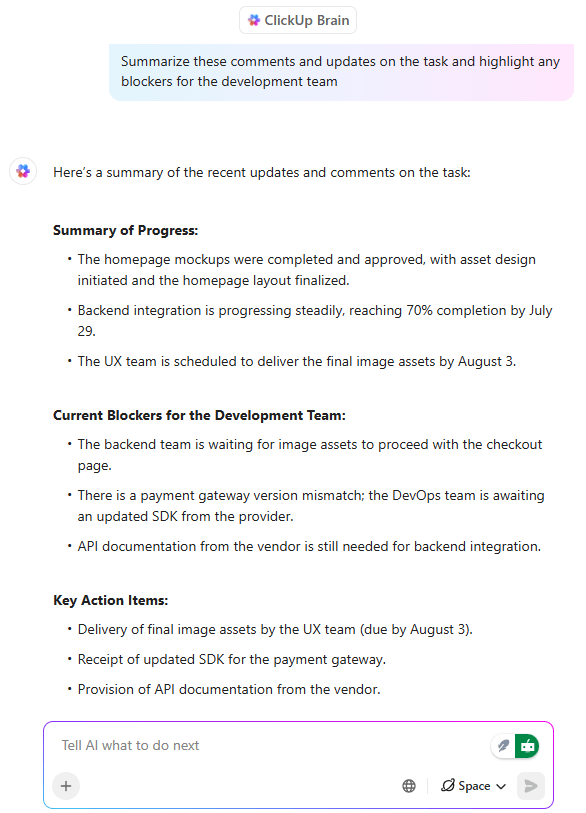
The different ways your HR team can use Brain are:
⭐ Answer questions instantly: Ask Brain, “What’s the status of onboarding for Sarah?” or “Which candidates are pending background checks?” and it pulls the answer directly from your workspace.
⭐ Summarize HR docs in seconds: Long employee handbooks, policy updates, or training manuals can overwhelm new hires. Brain condenses them into easy-to-digest summaries so employees engage with the material.
⭐ Turn conversations into action: After an interview debrief or onboarding call, Brain can auto-generate tasks—like “Schedule training session” or “Send IT equipment request” saving you the hassle of doing one more thing.
⭐ Keep knowledge centralized: Whether it’s SOPs, compliance workflows, or performance management playbooks, Brain ensures you have a single, always-updated source of truth instead of scattered files.
🌟 Bonus: ClickUp Brain MAX takes everything you get with ClickUp Brain to the next level. You might have used ChatGPT for writing, Claude for analysis, and other AI tools for different tasks. Brain MAX brings all of them together.
It understands your entire HR ecosystem, like your hiring pipeline, employee data, and team relationships. You can simply ask it to ‘Create an onboarding plan for a new marketing hire,’ and get a personalized plan for your actual processes.
That’s not all. You can also use ClickUp Brain MAX to:
Ditch the AI tool sprawl with ClickUp Brain MAX, use your voice to get work done, create documents, assign tasks to team members, and more.
Even the smartest AI will not deliver results if your HR data is messy. Duplicate employee records, outdated payroll information, and inconsistent formats create errors and break the automation workflow entirely.
Before you roll out AI, take time to standardize and clean your data so your systems are speaking the same language.
Why does this matter?
But with ClickUp for HR Teams, data cleaning becomes centralized and standardized.
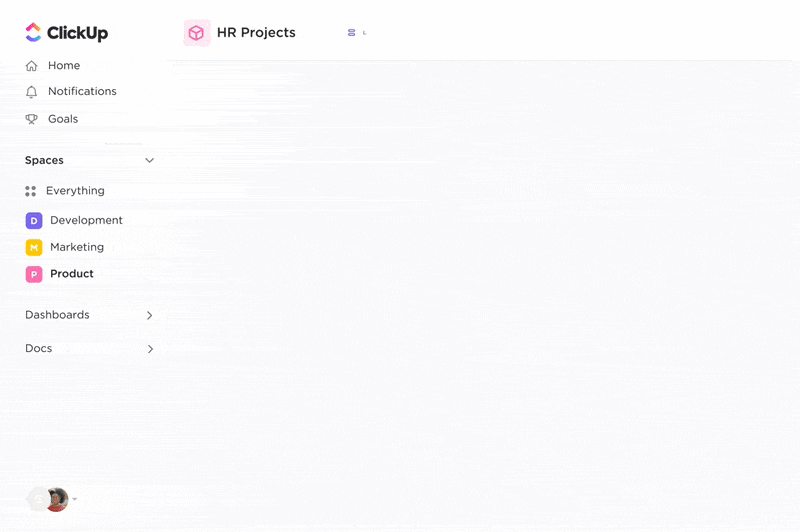
Here’s how:
Capture employee details, like department, role, manager, or location, using dropdowns and pre-set options in Custom Fields. This eliminates guesswork and prevents multiple variations for each of these triggers.
In processes like onboarding, certain steps depend on others being completed. Say, verifying ID before issuing equipment. ClickUp’s Dependencies ensure data flows in the right order, so nothing slips through and your automations trigger at the right time.
ClickUp Automations enable HR teams to build self-running workflows. They’re designed with three elements:
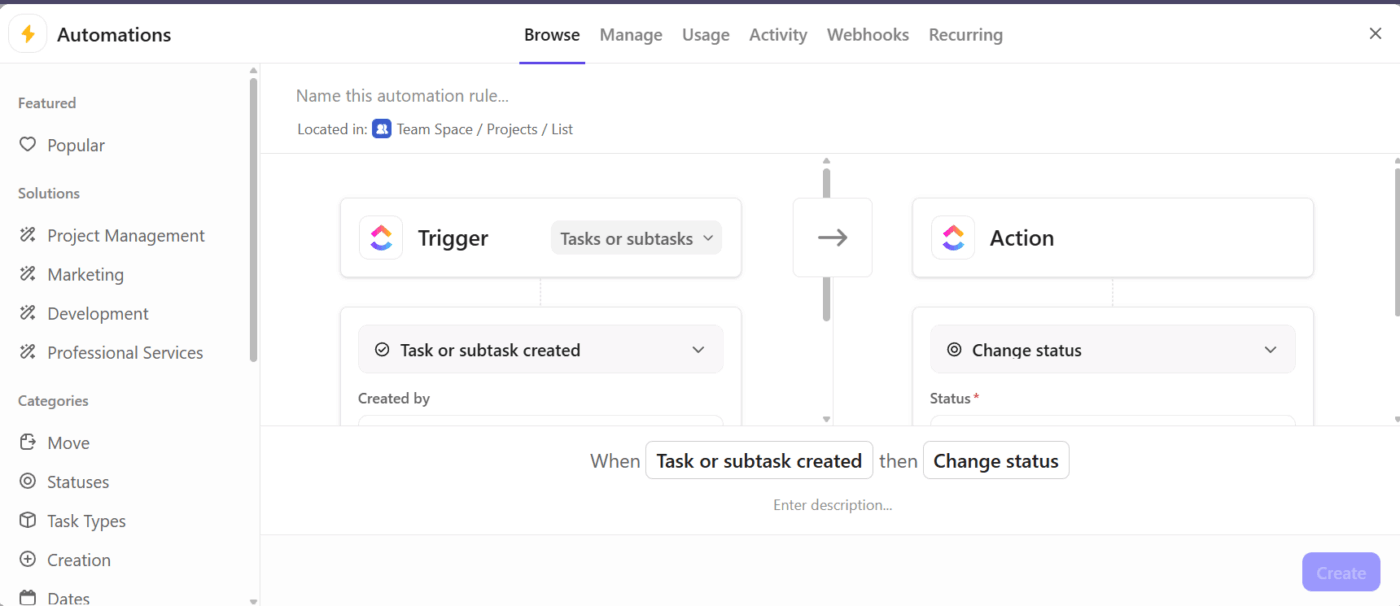
For instance, when a new resume is added to your system, use AI to automate task creation for candidates. It’ll also assign it to your recruiting lead while also setting the status to ‘Initial Review.’
The platform has afforded us one location for creating process efficiencies. ClickUp team consists of stellar team members who are always open to feedback and they work hard to implement changes based on that feedback. It’s a support system like I’ve never seen. All teams can benefit from automation and ClickUp has had that for literally every scenario I have encountered, however, the BIG plus to ClickUp is the simplification of processes and tools into one work zone.
Start a small pilot. Pick one process, say interview scheduling or policy FAQs, to run this pilot. Gather feedback from recruiters, managers, and employees, then refine your workflows before rolling them out org-wide.
This also builds the confidence of your HR organization in the automation rollout.
At this stage, use ClickUp Docs to create step-by-step guides, FAQs, and onboarding materials for your HR team. As you refine the pilot, you can update the documentation in real time so everyone stays aligned. Docs also serve as a permanent record of “what worked” and “what didn’t,” making it easier to scale later.
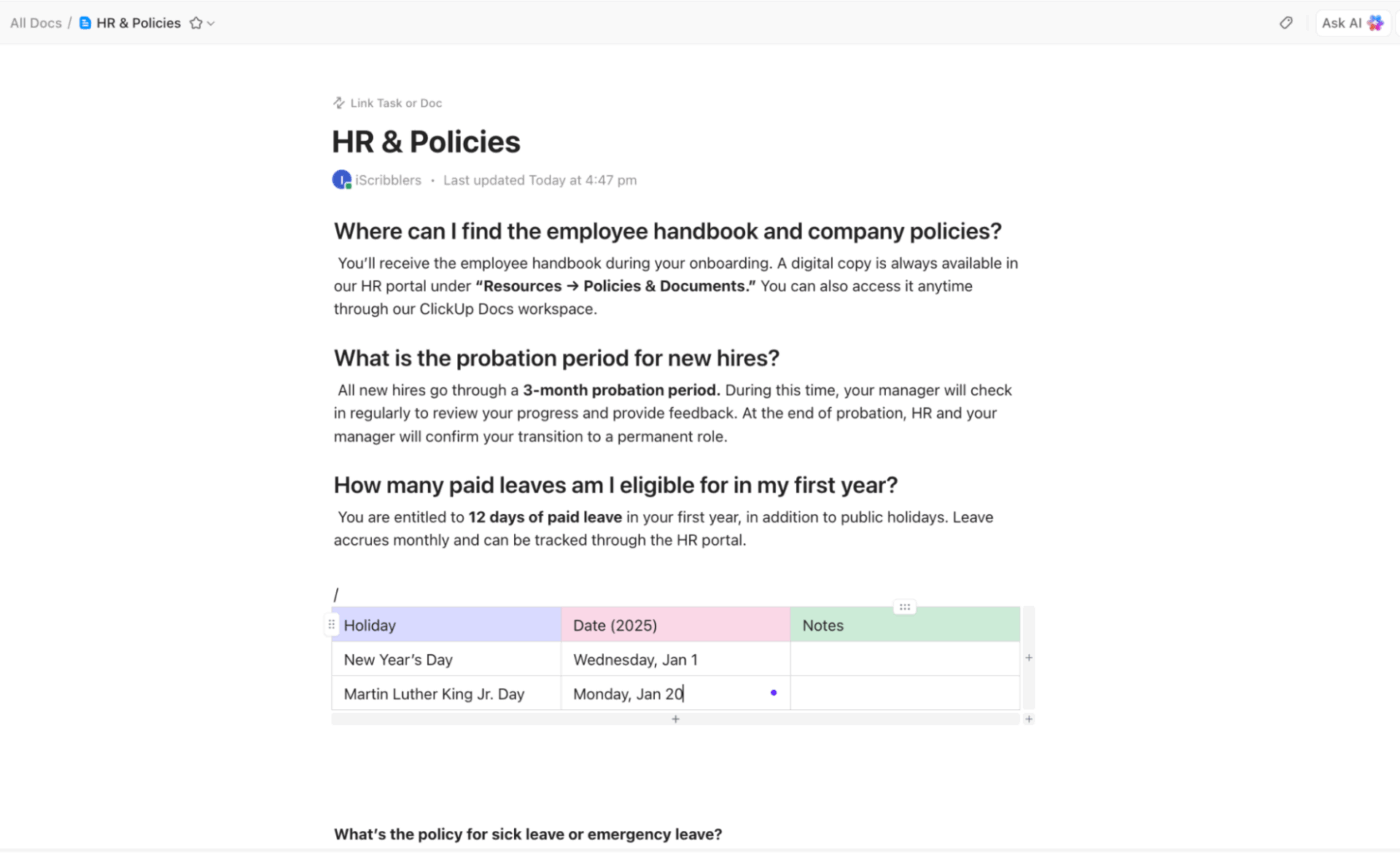
Even with a well-designed pilot, your HR team may still drown in repetitive queries. Instead of adding more manual effort, this is the perfect stage to test ClickUp’s Autopilot Agents that respond, act, and learn alongside your team.
Example in practice: You’re piloting automation for policy FAQs.
A recruiter types, “What’s the probation period for new hires?” The Autopilot Agent recognizes the query, checks your policy Doc, and replies with the exact clause. If the Doc is outdated or unclear, you’ll know immediately, giving you feedback to refine both your automation and your documentation.
This video will guide you through setting up your first Autopilot Agent on ClickUp:
Automation only works as well as the people behind it. You want to show AI as a productivity amplifier, not as a black box. Considering 65% of HR teams and leaders are already using generative AI in some capacity.
Critical fundamentals to highlight when you introduce AI automation for the HR function:
💡 Pro Tip: Use ClickUp Clips to create quick screen recordings showing exactly how the new automation works. You can record 2-minute clips demonstrating ‘Processing leave requests with AI.’ Share these bite-sized tutorials directly in your training docs.
HR automation isn’t a “set it and forget it” exercise. Even the smartest workflows can drift off course if they’re not monitored, tested, and refined over time. Policies evolve, compliance rules change, and employee expectations shift. Your automation needs to keep up with all these changes.
How do you do this?
With ClickUp Dashboards, you can track the real-time performance of your automations. See whether time-to-hire is trending down, whether data accuracy targets are being hit, or if employee support tickets are dropping.
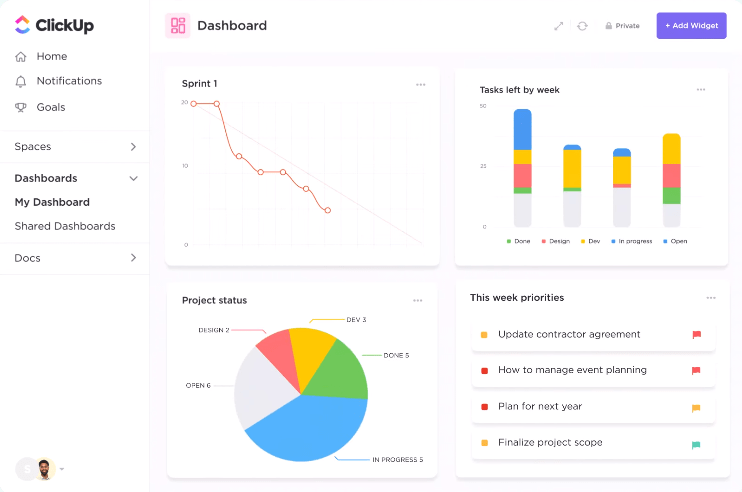
Example in practice: Your goal is to reduce manual HR inquiries by 40%. A ClickUp Dashboard can show whether helpdesk ticket volume is dropping, while Forms capture feedback on unanswered questions. Together, this gives you both the numbers and the context to refine your automation further.
You’ve mapped your processes and set your goals; now, let’s discuss some AI tools for HR that can handle repetitive tasks while you focus on HR’s human side.
| Tool Name | Primary Function | Strengths | Use Case |
| ClickUp | All-in-one work management & HR automation | Centralizes HR tasks in one platform, combines AI (ClickUp Brain) with Automations, real-time Dashboards, and integrated Docs for a single source of truth | HR teams wanting to streamline recruitment, onboarding, performance reviews, and compliance in one collaborative workspace |
| Multiplier | Global payroll & Employer of Record (EOR) | Strong global compliance across 150+ countries, multi-currency payroll, and contractor support | Companies hiring or managing international employees and contractors while staying compliant with local laws |
| Leena AI | HR chatbot & employee self-service | Conversational AI for policy FAQs and HR queries, sentiment analysis, and integrates with HRIS platforms | Enterprises looking to offer 24/7 HR support and free up HR managers from low-value queries |
| ClearCompany | Performance management and talent lifecycle | Strong goal alignment tools, robust analytics, succession planning, and integrated talent management across the employee lifecycle | Organizations that need structured performance management and long-term talent development |
| Moveworks | Conversational HR automation | Enterprise-grade chatbot with workflow routing, integrates HR and IT requests, and automates ticket resolution at scale | Enterprise HR/IT teams seeking a single conversational platform for employee support and workflow management |
| Deel | Global hiring and payroll | Simplifies cross-border hiring, automates compliance and tax filings, and fast onboarding for contractors and full-time employees | Remote-first teams needing reliable global hiring and compliant payroll |
Our editorial team follows a transparent, research-backed, and vendor-neutral process, so you can trust that our recommendations are based on real product value.
Here’s a detailed rundown of how we review software at ClickUp.
Automation in HR is less about replacing people and more about removing the repetitive tasks that keep your human resource teams from doing their best work.
Here are the common HR challenges that you must look out for:
Why it happens: Automation projects are driven by IT without HR’s active involvement, risking the latter’s strategic role.
✅ Solution: Communicate the “why” clearly—how automation frees HR to focus on culture, engagement, and retention. Pair this with small, visible wins (like faster interview scheduling) to build trust and momentum across the organization.
Why it happens: HR leaders assume cybersecurity is IT’s responsibility, overlooking the fact that HR data—payroll, contracts, performance reviews—is among the most sensitive in the organization.
✅ Solution: Require encryption for all employee records, use strict role-based access controls, and conduct regular security audits.
📌 ClickUp offers robust permission controls and audit trails so only authorized users can view sensitive HR information.
Why it happens: In the rush to automate, HR teams sometimes deploy AI that monitors communications, tracks productivity, or processes sensitive data. This, without explaining it clearly to employees, leads to distrust.
✅ Solution: Clearly communicate what data is being collected, how it will be used, and what safeguards protect employee information.
📌 ClickUp helps safeguard privacy with granular permission settings, private views, and audit logs, ensuring employees know their personal data is protected and only accessed by the right people.
Why it happens: Remember that automation tools are not plug-and-play. If you underestimate the time needed for data cleanup, workflow testing, user training, and change management, it will lead to rushed rollouts and frustrated teams.
✅ Solution: Set realistic timelines by starting with a pilot and phasing automation in gradually. Build time for testing, feedback, and iteration into your plan.
AI systems are ready to take over manual tasks, that is, if you’re ready to hand them over.
The right tools make the hiring process smooth and less stressful for the HR department.
ClickUp, the everything app for work, offers an extensive suite of features to aid you at every step.
With ClickUp Brain, Brain MAX, and Autopilot Agents, you get an all-in-one workspace where every HR process runs smoothly. Plus, Docs, Whiteboards, and Goals cover all the other aspects of your HR workflow.
Ready to automate your HR processes? Sign up on ClickUp for free today.
© 2025 ClickUp